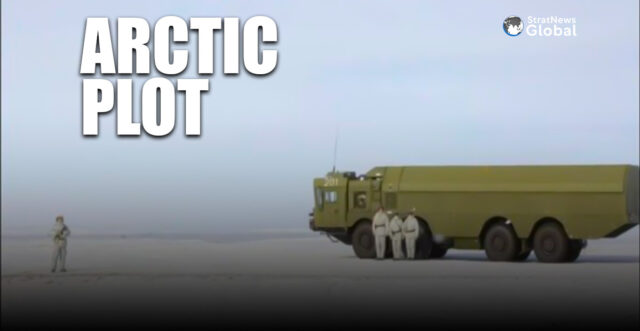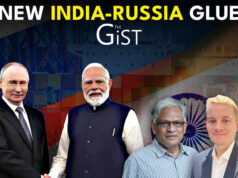
The Arctic Circle could soon become another major geopolitical flashpoint.
Former U.S. National Security Advisor Zbigniew Brzeziński wrote The Grand Chessboard in 1997, an influential book which visualized the world as a chessboard, and geopolitics as a game of chess between powerful factions.
It is easy to see why such visual analogies resonate with readers, since geography is a useful (and often accurate) prism through which to make sense of the world.
But what would happen to this game of chess if new squares opened up on the board? How would the players react if hitherto unusable squares became playable? This is precisely what is unfolding as the Arctic Circle thaws, creating a new playground (or battlefield) for both trade routes and resource extraction.
An inhospitable chunk of the world is gradually becoming more suitable for human activity, and the implications of this transition are largely unclear. The only thing we know for sure is that the players have already begun moving their pawns. Here’s a look at the game so far.
To begin with, the institution mediating issues in this region – the Arctic Council – is itself in disarray thanks to the Russia-Ukraine war and the re-election of Donald Trump.
The eight members of this Council, founded in 1996, are the nations whose territories fall within the Arctic Circle – Canada, Denmark, Finland, Iceland, Norway, Russia, Sweden and the United States. Despite having eight members, over 90% of the entire Arctic Circle is actually covered by just three – Russia, Canada and Denmark. The others, including the U.S. (through Alaska) only have a small presence in the region.
The importance of the Arctic is easy to see; melting ice sheets and technological breakthroughs in shipping design have opened up the potential to create routes from Western Europe to East Asia significantly shorter than our current options. It is called the Northern Sea Route, or NSR.
A shipment from London to Shanghai for example, would no longer have to sail around Africa, or through the Suez Canal, and subsequently traverse the Indian Ocean. Instead, companies could substantially reduce time and cost by sailing North, slicing through the Arctic to reach China or Japan. Some estimates say the route could reduce transit time between northeast Asia and Europe, by at least 40 percent compared to the route that goes via the Suez Canal. In other words, A voyage from Japan to Europe can take about 10 days via the NSR, compared to 22 days via the Suez Canal.
In addition, the region is believed to be rich with oil, natural gas, diamonds and rare earth metals, turning it into a likely hotspot for resource competition as well.
The most important player here, naturally, is Russia, half of whose coastline is Arctic.
This brings up the first major complication – for any sea lane through this region to be viable, passing ships must have the blessings of Moscow. Given the ceaseless volatility of the West’s relationship with Russia, this seems increasingly improbable.
The impact of Houthi violence on key shipping chokepoints like the Strait of Hormuz and Suez Canal, has demonstrated just how quickly trade routes can fall prey to geopolitical turbulence. Most Western powers would be reluctant to adopt sea routes where Russia’s navy is the sole guarantor of security.
This would explain why, despite years of hype, we have not seen many companies switching over to an Arctic route, even if it means saving money and time. The first two way crossing of the Arctic was in 2021, and the lane has simply not boomed as much as predicted. However, countries like India, enjoying a longstanding friendship with Russia, could benefit from this vacuum.
The next factor at play is China, which although far from the Arctic Circle, declared itself a “Near-Arctic” State in a 2018 white paper, and has since used terminology like “polar silk road” to insist Beijing too is an important stakeholder in how the Arctic chess game progresses.
China has worked closely with Russia, with Beijing having invested an estimated 90 billion USD for energy and resource projects in the Arctic since 2010. With the deterioration of Russia’s relationship with the West (and by extension, the rest of the Arctic Council), China is favorably placed to become the second big player soon, although it must be noted that some have pointed to a potential China-Russia rivalry in the region as well.
American policy has been no less important. One of the most important geopolitical events in recent history was the Shale Revolution, which single-handedly turned the U.S. from a nation that was stereotyped in many parts of the world as an oil-grabbing imperial power, to the world’s largest supplier of natural gas.
Last year, Washington signed the ICE pact with Canada and Finland to build a fleet of icebreakers (specially designed ships to cut through Arctic ice) that would help them navigate through the Circle. Finland is currently the only true powerhouse in the manufacturing of these icebreakers and such a pact could propel America’s naval presence in the region to a much higher level.
Given the robust mandate of Donald Trump to revitalize the economy, there is little doubt that Washington will be eyeing Arctic resources even more so than before as a potential goldmine to kickstart a revival. But whether they choose to follow this path unilaterally is a far trickier question to answer.
Considering Trump’s rhetoric about NATO, his alleged friendship with Putin and his general preference for strategic autonomy, the Arctic Council’s future as a multilateral institution seems increasingly perilous.
This brings us to a question of both practical and moral significance – the environment. On one hand, the thawing of Arctic ice presents a great opportunity to create prosperity, with all these untapped resources and shorter trade routes. But on the other, it could be argued that the thawing of the Arctic ice itself represents humanity’s failure to protect our habitats and combat climate change.
It is symbolic of the way in which resource grabs and global economics have neutered environmental concerns for financial rewards, the consequences of which are still largely unknown not us, but will impact future generations to come. Would this lead to us wreaking irreversible damage to the planet? Would this lead to a resource race that exacerbates a future world war? Only time will tell.
Ironically, it might be the environment itself which puts an end to all this hype. While the Arctic region looks attractive for travel and resource extraction when one looks at the world map, the actual situation on the ground is very different. Random sheets of floating ice make seafaring extremely perilous, and the bad light only turns it even more hazardous, with no fixed routes that can be guaranteed.
Despite the region becoming more hospitable thanks to a warming planet, it still remains a dark, chaotic, icy wasteland requiring significant equipment for basic survival and travel. We have begun to tame it, but are far from being able to call ourselves its master. And as the world moves towards greener energy, it could even be possible that the estimated 400 billion barrels of oil, do not trigger a race as big as we expect.
The Arctic Chess Game is thus on and will certainly evolve as we move into the next decade. However, what we see now are merely the opening gambits of the players, in a game that is as likely to end in a damp squib stalemate as an exhilarating checkmate.
Nilanthan Niruthan is the Executive Director of the Centre for Law And Security Studies and a geopolitical analyst. His frequently writes for international publications on diverse issues like global security, international law and geopolitical trends. He is also a lecturer at the National Defense College, the highest institution of military education in Sri Lanka.




